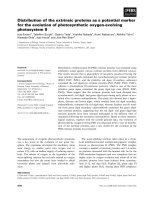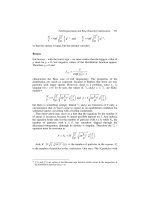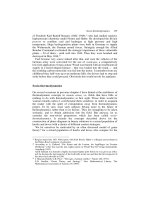Seam Framework Experience the Evolution of Java EE 2nd phần 1 ppt
Bạn đang xem bản rút gọn của tài liệu. Xem và tải ngay bản đầy đủ của tài liệu tại đây (369.96 KB, 50 trang )
ptg
Simpo PDF Merge and Split Unregistered Version -
ptg
Seam Framework
Second Edition
From the Library of sam kaplan
Simpo PDF Merge and Split Unregistered Version -
ptg
This page intentionally left blank
From the Library of sam kaplan
Simpo PDF Merge and Split Unregistered Version -
ptg
Seam Framework
Experience the Evolution of Java
TM
EE
Second Edition
Michael Juntao Yuan
Jacob Orshalick
Thomas Heute
Upper Saddle River, NJ • Boston • Indianapolis • San Francisco
New York • Toronto • Montreal • London • Munich • Paris • Madrid
Capetown • Sydney • Tokyo • Singapore • Mexico City
From the Library of sam kaplan
Simpo PDF Merge and Split Unregistered Version -
ptg
Many of the designations used by manufacturers and sellers to distinguish their products are claimed as
trademarks. Where those designations appear in this book, and the publisher was aware of a trademark
claim, the designations have been printed with initial capital letters or in all capitals.
The authors and publisher have taken care in the preparation of this book, but make no expressed or implied
warranty of any kind and assume no responsibility for errors or omissions. No liability is assumed for
incidental or consequential damages in connection with or arising out of the use of the information or
programs contained herein.
The publisher offers excellent discounts on this book when ordered in quantity for bulk purchases or special
sales, which may include electronic versions and/or custom covers and content particular to your business,
training goals, marketing focus, and branding interests. For more information, please contact:
U.S. Corporate and Government Sales
(800) 382-3419
For sales outside the United States please contact:
International Sales
Visit us on the Web: informit.com/ph
Library of Congress Cataloging-in-Publication Data
Yuan, Michael Juntao.
Seam framework : experience the evolution of Java EE / Michael Juntao Yuan,
Jacob Orshalick, Thomas Heute.—2nd ed.
p. cm.
Includes index.
ISBN 978-0-13-712939-3 (pbk. : alk. paper)
1. JBoss. 2. Web servers—Management. 3. Java (Computer program language)
I. Orshalick, Jacob. II. Heute, Thomas. III. Title.
TK5105.8885.J42Y832 2009
005.2'762—dc22
2008047478
Copyright © 2009 Pearson Education, Inc.
All rights reserved. Printed in the United States of America. This publication is protected by copyright,
and permission must be obtained from the publisher prior to any prohibited reproduction, storage in a
retrieval system, or transmission in any form or by any means, electronic, mechanical, photocopying,
recording, or likewise. For information regarding permissions, write to:
Pearson Education, Inc.
Rights and Contracts Department
501 Boylston Street, Suite 900
Boston, MA 02116
Fax (617) 671-3447
ISBN-13: 978-0-13-712939-3
ISBN-10: 0-13-712939-4
Text printed in the United States on recycled paper at R.R. Donnelley in Crawfordsville, Indiana.
First printing, February 2009
From the Library of sam kaplan
Simpo PDF Merge and Split Unregistered Version -
ptg
Michael dedicates the book to Ju.
Jacob dedicates the book to Jennifer and Talia.
Thomas dedicates the book to Isabelle.
From the Library of sam kaplan
Simpo PDF Merge and Split Unregistered Version -
ptg
This page intentionally left blank
From the Library of sam kaplan
Simpo PDF Merge and Split Unregistered Version -
ptg
xviiAbout This Book
xixAbout the Authors
xxiAcknowledgments
1Getting Started PART I
3What Is Seam? Chapter 1
1.1 Integrating and Enhancing Java EE Frameworks 4
1.2 A Web Framework That Understands ORM 5
1.3 Supporting Stateful Web Applications 6
1.4 Web 2.0 Ready 7
1.5 POJO Services via Dependency Bijection 7
1.6 Convention over Configuration 8
1.7 Avoiding XML Abuse 8
1.8 Designed for Testing 9
1.9 Great Tools Support 10
1.10 Let’s Start Coding! 10
11Seam Hello World Chapter 2
2.1 Create a Data Model 13
2.2 Map the Data Model to a Web Form 13
2.3 Handle Web Events 14
2.4 Navigate to the Next Page 15
2.5 EJB3 Bean Interface and Mandatory Method 16
2.6 More on the Seam Programming Model 17
2.6.1 Seam Built-in Components 17
2.6.2 Ease of Testing 18
2.6.3 Getter/Setter-Based Bijection 18
2.6.4 Avoid Excessive Bijection 19
2.6.5 Accessing Database via the EntityManager 20
Contents
vii
From the Library of sam kaplan
Simpo PDF Merge and Split Unregistered Version -
ptg
2.7 Configuration and Packaging 20
2.7.1 The WAR File 22
2.7.2 The Seam Components JAR 24
2.8 How Is This Simple? 25
27Recommended JSF Enhancements Chapter 3
3.1 An Introduction to Facelets 28
3.1.1 Why Facelets? 29
3.1.2 A Facelets Hello World 30
3.1.3 Use Facelets as a Template Engine 31
3.1.4 Data List Component 34
3.2 Seam JSF Enhancements 34
3.2.1 Seam UI Tags 34
3.2.2 Seam JSF EL Enhancement 36
3.2.3 Use EL Everywhere 37
3.2.4 Seam Filter 37
3.2.5 Stateful JSF 38
3.3 Add Facelets and Seam UI Support 38
3.4 PDF, Email, and Rich Text 40
3.4.1 Generate PDF Reports 40
3.4.2 Template-Based Email 42
3.4.3 Display Rich Text 44
3.5 Internationalization 46
47Seam without EJB3 Chapter 4
4.1 A Seam POJO Example 47
4.2 Configuration 48
4.3 Packaging 50
4.4 POJO Trade-Offs 52
53Rapid Application Development Tools Chapter 5
5.1 Prerequisites 54
5.2 A Quick Tutorial 54
5.2.1 Setting Up Seam-gen 54
5.2.2 Generating a Skeleton Application 57
5.2.3 Understand the Profiles 59
5.2.4 Developing the Application 61
5.2.5 Building and Deploying 61
5.2.6 Running Test Cases 63
5.3 Working with IDEs 63
5.3.1 NetBeans 63
CONTENTS
viii
From the Library of sam kaplan
Simpo PDF Merge and Split Unregistered Version -
ptg
5.3.2 Eclipse 67
5.3.3 JBoss Tools and JBoss Developer Studio 68
5.4 Generating a CRUD Application from a Database 72
5.5 Seam-gen Command Reference 73
75Stateful Applications Made Easy PART II
77An Introduction to Stateful Framework Chapter 6
6.1 Correct Usage of ORM 77
6.2 Better Performance 79
6.3 Better Browser Navigation Support 81
6.4 Fewer Memory Leaks 82
6.5 High Granularity Component Lifecycle 83
6.6 Reducing Boilerplate Code 84
87Thinking in Components Chapter 7
7.1 Stateful Components 87
7.1.1 Stateful Entity Bean 90
7.1.2 Stateful Session Bean 90
7.2 Managing Stateful Components 92
7.2.1 Stateful Component Lifecycle 92
7.2.2 Factory Methods 94
7.2.3 Manager Components 96
7.3 Configuring Components through XML 97
7.4 Page Navigation Flow 99
101Conversations Chapter 8
8.1 What Is a Conversation? 102
8.1.1 The Default Conversation Scope 102
8.1.2 Displaying JSF Messages 104
8.2 Long-Running Conversations 106
8.2.1 Introducing the Hotel Booking Example 106
8.2.2 The Lifecycle of a Long-Running Conversation 110
8.2.3 Conversation Timeout 111
8.3 Managing Long-Running Conversations 112
8.3.1 The Annotation Approach 112
8.3.2 The Navigation Approach 113
8.3.3 Beginning a Long-Running Conversation 115
8.3.4 Inside the Conversation 117
8.3.5 Ending a Long-Running Conversation 119
8.3.6 Links and Buttons 123
8.4 New Frontiers 124
ix
CONTENTS
From the Library of sam kaplan
Simpo PDF Merge and Split Unregistered Version -
ptg
125Workspaces and Concurrent Conversations Chapter 9
9.1 What Is a Workspace? 125
9.2 Workspace Management 129
9.2.1 Workspace Switcher 130
9.2.2 Carrying a Conversation across Workspaces 132
9.2.3 Managing the Conversation ID 133
9.3 Natural Conversations 134
9.3.1 Beginning a Natural Conversation via Links 135
9.3.2 Redirecting to a Natural Conversation 137
9.3.3 Resuming a Natural Conversation 138
9.3.4 Rewriting to User-Friendly URLs 139
9.4 Workspace Timeout 140
9.5 Desktop Features in a Stateless Web 143
145Nested Conversations Chapter 10
10.1 Why Are Nested Conversations Needed? 145
10.2 Continuing the Conversation 147
10.2.1 Understanding the Nested Conversation Context 148
10.2.2 Nesting Conversations 149
10.3 The Conversation Stack 152
10.3.1 Managing the Conversation Stack 152
10.3.2 Displaying Breadcrumbs 156
10.3.3 Nested Conversation Timeout 156
10.4 Fine-Grained State Management 157
159Transactions and Persistence Chapter 11
11.1 Seam-Managed Transactions 160
11.1.1 Transactional Attributes 162
11.1.2 Forcing a Transaction Rollback 164
11.2 Atomic Conversation (Web Transaction) 165
11.2.1 Managing the Persistence Context 165
11.2.2 Seam-Managed Persistence Contexts 167
11.2.3 One Transaction per Conversation 172
175Integrating Web and Data Components PART III
177Validating Input Data Chapter 12
12.1 Form Validation Basics 177
12.2 Validation Annotations on Entity Beans 179
12.3 Triggering the Validation Action 181
12.4 Displaying Error Messages on the Web Form 183
12.5 Using JSF Custom Validators 185
CONTENTS
x
From the Library of sam kaplan
Simpo PDF Merge and Split Unregistered Version -
ptg
187Clickable Data Tables Chapter 13
13.1 Implementing a Clickable Data Table 188
13.1.1 Displaying a Data Table 188
13.1.2 Injecting Selected Object into an Event Handler 189
13.1.3 Using Extended EL in a Data Table 190
13.2 Seam Data-Binding Framework 191
193Decoupling Components Using Events Chapter 14
14.1 The Observer Pattern 193
14.2 Component-Driven Events 196
14.2.1 Raising Events Declaratively 196
14.2.2 Observing Events 198
14.2.3 Event Processing and the Events API 199
203Bookmarkable Web Pages Chapter 15
15.1 Using Page Parameters 204
15.2 The Java-Centric Approach 207
15.2.1 Obtaining Query Parameters from an HTTP GET Request 208
15.2.2 Loading Data for the Page 208
15.2.3 Further Processing from the Bookmarked Page 210
15.3 RESTful Web Services 211
213The Seam CRUD Application Framework Chapter 16
16.1 Data Access Objects (DAOs) 213
16.2 Seam CRUD DAOs Are POJOs 214
16.3 A Declarative Seam DAO Component 215
16.3.1 Using Simpler Names for the Entity Object 216
16.3.2 Retrieving and Displaying an Entity Object 217
16.3.3 Initializing a New Entity Instance 217
16.3.4 Success Messages 217
16.4 Queries 218
16.4.1 Dynamic Queries 219
16.4.2 Displaying Multipage Query Results 221
223Failing Gracefully Chapter 17
17.1 Why Not Standard Servlet Error Pages? 223
17.2 Setting Up the Exception Filter 225
17.3 Annotating Exceptions 225
17.4 Using pages.xml for System Exceptions 227
17.5 The Debug Information Page 229
17.5.1 The Facelets Debug Page 229
17.5.2 The Seam Debug Page 230
xi
CONTENTS
From the Library of sam kaplan
Simpo PDF Merge and Split Unregistered Version -
ptg
233Seam Security Chapter 18
18.1 Authentication and User Roles 234
18.2 Declarative Access Control 237
18.2.1 Page Access 238
18.2.2 UI Components 239
18.2.3 Component Access Control 240
18.2.4 Type-Safe Role Annotations 242
18.3 Identity Management 243
18.3.1 Using the JpaIdentityStore 244
18.3.2 Using the LdapIdentityStore 250
18.4 Additional Security Features 251
18.4.1 Simplified SSL 251
18.4.2 Telling Humans and Computers Apart with CAPTCHA 253
257AJAX Support PART IV
259Custom and AJAX UI Components Chapter 19
19.1 Autocompletion Text Input Example 261
19.2 Rich Input Control Examples 263
19.3 A Scrollable Data Table 264
19.4 Using RichFaces with Seam 265
19.5 Other JSF Component Libraries 266
269Enabling AJAX for Existing Components Chapter 20
20.1 AJAX Validator Example 270
20.2 Programmatic AJAX 272
20.3 AJAX Buttons 274
20.4 AJAX Containers 276
20.5 Other Goodies 276
20.6 Using Ajax4jsf with Seam 277
20.7 Pros and Cons 278
279Direct JavaScript Integration Chapter 21
21.1 AJAX Validator Example (Reloaded) 280
21.1.1 Server-Side Component 280
21.1.2 Triggering a JavaScript Event on a Web Page 281
21.1.3 Making an AJAX Call 282
21.2 AJAX Progress Bar 284
21.2.1 Seam Components 285
21.2.2 Accessing Seam Components from JavaScript 286
21.3 Integrating the Dojo Toolkit 287
21.3.1 Visual Effects 288
21.3.2 Input Widgets 289
CONTENTS
xii
From the Library of sam kaplan
Simpo PDF Merge and Split Unregistered Version -
ptg
293Business Processes and Rules PART V
295Rule-Based Security Framework Chapter 22
22.1 Rule-Based Access Control 295
22.2 Configuring Rule-Based Permissioning 296
22.3 Simple Access Rules 297
22.4 Per-Instance Access Rules 299
22.5 Securing Your Entities 302
305Integrating Business Rules in Web Applications Chapter 23
23.1 Embedded Rules 305
23.1.1 Rule-Based Behavior 306
23.1.2 Applying Rules 306
23.2 Generic Rules 309
23.2.1 The Working Memory 309
23.2.2 Using the Working Memory 310
23.2.3 Dynamically Updatable Rules 311
23.3 Building and Deployment 312
23.4 Conclusions 313
315Managing Business Processes Chapter 24
24.1 jBPM Concepts and Vocabulary 316
24.2 Application Users and jBPM Actors 318
24.3 Creating a Business Process 320
24.3.1 Defining the Process 320
24.3.2 Creating a Business Process Instance 323
24.3.3 Binding Data Objects in Process Scope 323
24.4 Managing Tasks 325
24.4.1 Implementing Business Logic for Tasks 325
24.4.2 Specifying a Task to Work On 327
24.4.3 Selecting a Task in the UI 328
24.5 Business Process-Based Page Navigation Flow 330
24.6 jBPM Libraries and Configuration 333
335Integrating Business Processes and Rules Chapter 25
25.1 The Process 335
25.2 The Rules 337
25.3 Conclusions 338
339Testing Seam Applications PART VI
341Unit Testing Chapter 26
26.1 A Simple TestNG Test Case 343
26.2 Simulating Dependency Bijection 344
xiii
CONTENTS
From the Library of sam kaplan
Simpo PDF Merge and Split Unregistered Version -
ptg
26.3 Mocking the Database and Transaction 345
26.4 Loading the Test Infrastructure 347
351Integration Testing Chapter 27
27.1 Simulating JSF Interactions 352
27.2 Using JSF EL Expressions 353
27.3 Transactional Data Source 355
357Production Deployment PART VII
359Using a Production Database Chapter 28
28.1 Installing and Setting Up the Database 359
28.2 Installing the Database Driver 361
28.3 Defining a Data Source 361
28.4 Configuring the Persistence Engine 362
28.5 How about Tomcat? 362
365Java EE 5.0 Deployment Chapter 29
29.1 JBoss AS 4.0.5 365
29.2 JBoss AS 4.2.x and 5.x 366
29.3 GlassFish 367
371Performance Tuning and Clustering Chapter 30
30.1 Tuning Performance on a Single Server 372
30.1.1 Avoid Calling by Value 372
30.1.2 JVM Options 372
30.1.3 Reducing Logging 373
30.1.4 Tuning the HTTP Thread Pool 374
30.1.5 Choosing Between Client- and Server-Side State Saving 375
30.1.6 Using a Production Data Source 376
30.1.7 Using a Second-Level Database Cache 376
30.1.8 Using Database Transactions Carefully 378
30.2 Clustering for Scalability and Failover 379
30.2.1 Sticky Session Load Balancing 380
30.2.2 State Replication 380
30.2.3 Failover Architectures 381
383Emerging Technologies PART VIII
385Scheduling Recurring Jobs from a Web Application Chapter 31
31.1 Simple Recurring Events 386
31.2 Configuring the Quartz Scheduler Service 387
31.3 Scheduling Cron Jobs 389
CONTENTS
xiv
From the Library of sam kaplan
Simpo PDF Merge and Split Unregistered Version -
ptg
31.4 Scheduling Jobs When Starting Up 390
31.5 Conclusion 391
393Improving Scalability with Multilayered Caching Chapter 32
32.1 Multilayered Caching 394
32.2 Integrating a Cache Provider through Seam 396
32.3 Simplified Caching with Seam 398
401Making Seam Groovy Chapter 33
33.1 Groovy Entities 402
33.2 Groovy Actions 405
33.3 Integrating Groovy 406
409Introduction to Web Beans Chapter 34
34.1 Defining a Web Beans Component 410
34.2 Component Injection 411
34.3 Producer Methods 414
34.4 The Context Model 416
34.5 Component Stereotyping 419
34.6 Implementing Cross-Cutting Behavior 421
34.7 Conclusion 423
425Installing and Deploying JBoss AS Appendix A
A.1 JDK 5.0 Is Required 425
A.2 Installing JBoss AS 426
A.3 Deploying and Running Applications 426
427Using Example Applications as Templates Appendix B
B.1 Simple EJB3-Based Web Applications 428
B.2 POJO-Based Web Applications 433
B.3 More Complex Applications 438
441Using Maven Appendix C
451Direct Access to the Hibernate API Appendix D
D.1 Using the Hibernate API 451
D.2 Configuration 453
455Index
xv
CONTENTS
From the Library of sam kaplan
Simpo PDF Merge and Split Unregistered Version -
ptg
This page intentionally left blank
From the Library of sam kaplan
Simpo PDF Merge and Split Unregistered Version -
ptg
Six months after its initial release, JBoss Seam has already become one of the hottest
frameworks in enterprise Java, with more than 10,000 downloads per month. Seam in-
tegrates standard Java EE technologies with several nonstandard but interesting tech-
nologies into a consistent, unified programming model. These technologies include
JSF, EJB3, JPA, Hibernate, Facelets, jBPM, JBoss Rules (Drools), iText, and more.
Seam runs on almost all leading Java application servers, including but not limited
to JBoss AS and Tomcat.
This book is the first comprehensive guide to Seam written by developers from the
Seam team. We bring you the latest information on Seam, explain the rationales behind
its design, and discuss alternative approaches within Seam. Based on our real-world
experiences, we also give you tips and best practices on how to use Seam.
Of course, given the fast-evolving nature of Seam, the book will be playing catch-up
with new Seam releases, which come out almost every month. This book covers Seam
release 2.1.0. Subsequent releases of Seam should be at least compatible with 2.1.0 for
the foreseeable future. For readers who want to stay on the bleeding edge, we main-
tain blogs for the book at www.michaelyuan.com/blog and www.solutionsfit.com/blog
to bring you the latest updates on Seam. Come visit us there!
This book uses a series of example applications to illustrate how to write Seam applica-
tions. To download the source code for these sample applications, visit the book’s web
site at />About This Book
xvii
From the Library of sam kaplan
Simpo PDF Merge and Split Unregistered Version -
ptg
This page intentionally left blank
From the Library of sam kaplan
Simpo PDF Merge and Split Unregistered Version -
ptg
Michael Juntao Yuan is cofounder of Ringful, LLC, a company that develops
RESTful APIs for telephone voice and mobile messaging solutions. He contributes
code to the Seam project and writes about Seam at www.michaelyuan.com/blog.
Formerly technical product manager at Red Hat’s JBoss division, Yuan is author of
five books on software development.
Jacob Orshalick is an independent consultant and the owner of Focus IT Solutions,
LLC. He has developed enterprise software solutions that span the retail, financial,
media, and telecommunications industries. He specializes in developing enterprise Java
solutions utilizing open source technologies and agile techniques. He is a committer to
the Seam project, and you can find Jacob writing about Seam, Web Beans, and related
Java EE technologies in his blog, www.solutionsfit.com/blog.
Thomas Heute was a contributor to the pre-JBoss Portal project before being hired by
JBoss, Inc., in 2004. He started as a member of the JBoss Portal team but became
a JBoss Seam coleader in 2005, with a plan to bring EJB3 closer to JSF (where it really
should be). At the end of 2006, Thomas returned to the JBoss Portal team to work on
a range of tasks.
About the Authors
xix
From the Library of sam kaplan
Simpo PDF Merge and Split Unregistered Version -
ptg
This page intentionally left blank
From the Library of sam kaplan
Simpo PDF Merge and Split Unregistered Version -
ptg
First of all, we would like to thank the entire JBoss Seam community for their great
work. Like many other successful open source projects, Seam is a collaborative effort.
It would have been impossible without a very active and dedicated user community.
We have learned a great deal from Seam users on discussion forums, blogs, and mailing
lists. Thanks, guys, and keep up the good work!
Gavin King, Seam’s creator and lead developer, deserves special thanks. Seam would
never exist if not for his vision, brilliance, and hard work. Gavin was very supportive
of the book from the beginning. He patiently helped us with many of our newbie ques-
tions, reviewed the content, and offered encouragement along the way. Aside from
Gavin, other Seam developers, including Norman Richards, Pete Muir, Emmanuel
Bernard, Max Andersen, Shane Bryzak, James Williams, Christian Bauer, and Steve
Ebersole, were also very helpful. Seam is truly a team effort in the spirit of Open Source.
We’d also like to thank the following people for reviewing early editions of this book
and giving us great feedback: Ian White, Tony Herstell, Rich Rosen, Wes Boudville,
Bil Lewis, Gregory Pierce, David Geary, Bruce Scharlau, Kito Mann, Daniel Brum,
Chris Mills, Pete Muir, Srinivasan Raguraman, Ajay Gupta, and Chris Dempsey. Thank
you all for the help!
Our editorial team at Prentice Hall was extremely professional and supportive
throughout the process. Our editor, Greg Doench, and production staff, Anna Popick
and John Fuller, put up with our numerous delays and guided us through the complex
publishing process. Our production project managers, Alina Kirsanova and Dmitry
Kirsanov, worked tirelessly to enhance the look of the chapters and ensure their accuracy.
The book would not have been possible without their dedication.
Finally, and most importantly, we would like to thank our families for their love and
support. They are truly the unsung heroes behind any achievement we might have.
Acknowledgments
xxi
From the Library of sam kaplan
Simpo PDF Merge and Split Unregistered Version -
ptg
This page intentionally left blank
From the Library of sam kaplan
Simpo PDF Merge and Split Unregistered Version -
ptg
In this part, we provide an overview of JBoss Seam and its key features and benefits.
A simple Hello World example illustrates how Seam ties together the database, the web
UI, and the transactional business logic to form an application. We discuss the JSF en-
hancements Seam and Facelets provide that make JSF one of the best web application
frameworks around and ideal for Seam applications. For readers who do not want to
waste time setting up common Seam/Java EE configuration files, we introduce a tool
called seam-gen which generates projects with Eclipse and NetBeans IDE support. It’s
the best way to jump-start your Seam application.
Part I
Getting Started
1
From the Library of sam kaplan
Simpo PDF Merge and Split Unregistered Version -
ptg
This page intentionally left blank
From the Library of sam kaplan
Simpo PDF Merge and Split Unregistered Version -









